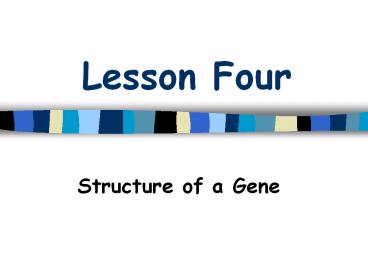Lesson Four - PowerPoint PPT Presentation
Title:
Lesson Four
Description:
Terminator sequences ... Terminator: bases that provide a signal to tell the cell's machinery where to ... terminator. Lesson Five. Transcription. Transcription ... – PowerPoint PPT presentation
Number of Views:14
Avg rating:3.0/5.0
Title: Lesson Four
1
Lesson Four
- Structure of a Gene
2
Gene Structure
- What is a gene?
- Gene a unit of DNA on a chromosome that codes
for a protein(s) - Exons
- Introns
- Promoter sequences
- Terminator sequences
- Other regulatory sequences (enhancers,
silencers), which may be far from major
components of a gene
3
Gene Structure
- Exons contain the bases that are utilized in
coding for the protein - Introns contain bases that are not utilized in
coding for proteins and intervene between the
exons - Introns are spliced out
4
Gene Structure
- Promoter bases that provide a signal to tell the
cells machinery where to begin transcription,
usually before or within a gene - Terminator bases that provide a signal to tell
the cells machinery where to stop transcription,
usually at the end of a gene
5
Gene Structure
- A typical gene might look something like this
- This gene has 3 exons and 2 introns
----------
exon
promoter
intron
----------
terminator
6
Lesson Five
- Transcription
7
Transcription
- The process of using DNA (a gene) as a template
to produce messenger RNA (mRNA) - Occurs in the nucleus
- Template strand the strand of DNA that is
accessed to make mRNA - Coding strand the strand of DNA that is NOT
accessed to make mRNA. The mRNA that is made
from the template strand will be identical to the
coding strand (with the exception of Us for Ts)
8
(No Transcript)
9
RNA Modification
- Trimming removing bases from the 5 and 3 ends
- Capping adding a methylated G to the 5 end
- Necessary for RNA localization to the ribosome
- Tailing addition of As to the 3 end of the
mRNA - More As more stabile mRNA
- Splicing removing introns prior to mRNA
transport to the nucleus
10
(No Transcript)
11
Lesson Six
- Translation
12
Translation
- The process of using mRNA as a template to
generate a polypeptide that will eventually
become a mature protein - Also called protein synthesis
- Requires the genetic code
- Based on 64 codons, each with 3 nucleotides
- Provides the link between DNA and protein sequence
13
Translation Requires Different Types of DNA
- mRNA messenger RNA major product of
transcription - Represents the code for the primary amino acid
sequence of a protein - Only type of RNA that is translated
- tRNA transfer RNA
- Recognizes the mRNA code (tri-nucleotide) and
brings with it (or transfers) the appropriate
amino acid to the protein - Link between mRNA and protein
- rRNA ribosomal RNA
- Part of the ribosomes
- Involved with translation by helping to align the
mRNAs and tRNAs
14
(No Transcript)
15
(No Transcript)
16
(No Transcript)
17
(No Transcript)
18
(No Transcript)
19
(No Transcript)
20
Protein Processing
Final transport
21
Genomics to Proteomics
Primary control of gene expression
22
Lesson Seven
- Mutations
23
Point Mutations
- Involves a single base pair
- Substitution, insertion, deletion
- SNPs
- May not affect amino acid sequence
- Same sense (silent, neutral, synonymous, same
sense) - Due to redundancy of the genetic code
- May affect amino acid sequence (nonsynonymous)
- Missense (results from a change in an amino acid)
- Nonsense (results from a change to a stop codon
truncated protein) - Frame shift mutations (insertion or deletion of
1 bases - alters the reading frame)
24
Missense Mutation Sickle Cell Anemia
25
(No Transcript)































